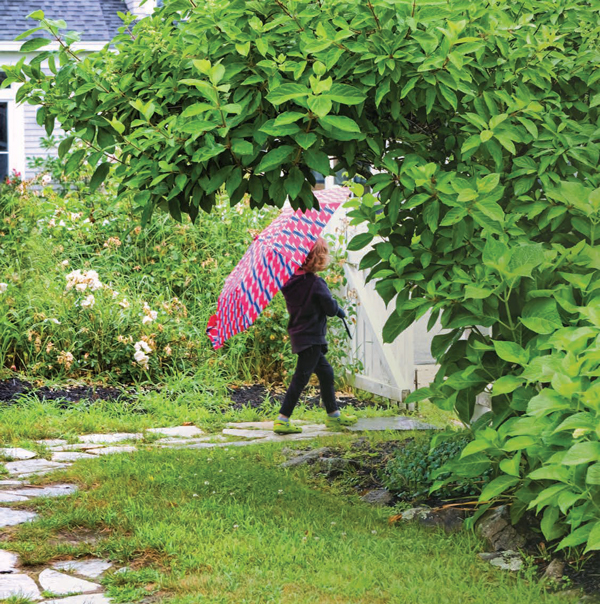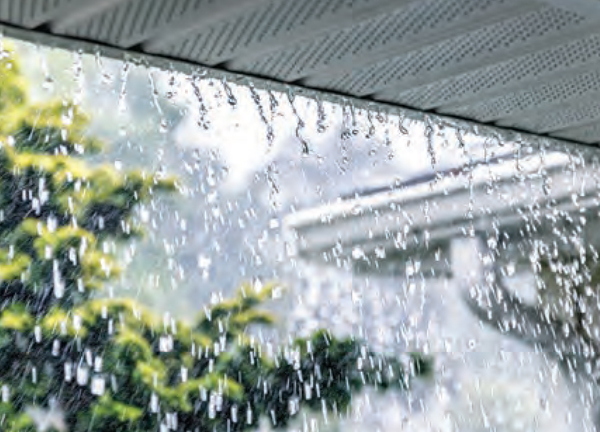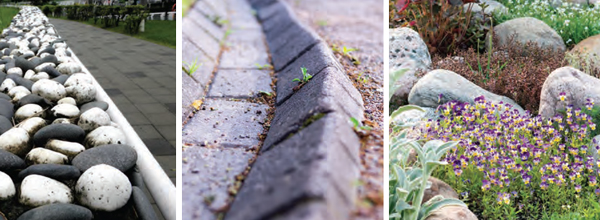Water Woes | Solving Drainage Issues in Your Yard

BEING DILIGENT WITH INSPECTIONS AROUND YOUR HOME AND IN YOUR YARD CAN HELP ELIMINATE FUTURE PROBLEMS THAT COULD LEAD TO COSTLY SOLUTIONS IF NOT REMEDIED.
While you can’t control the weather, you certainly can control the impact that rainwater has on your property. Poor water drainage is not only a problem affecting aesthetics, it is one of the most frustrating issues that a homeowner may face. Fear can be incited if those drainage problems on the lawn also creep toward or invade the home, create a haven for nuisance bugs, or impact enjoyment of your yard. Let’s identify some common water woes and explore solutions for these issues for maximum summer enjoyment of your yard.
Being diligent with inspections around your home and in your yard can help eliminate future problems that could lead to costly solutions if not remedied. Check these areas at least bi-annually, generally in the spring and fall, to evaluate the condition of your yard and home and whether drainage issues have arisen over time. Here is a homeowner checklist to get you started:
- Take a walk around the perimeter of your home. Does the ground that abuts your home’s foundation slope away from the home? Has erosion or settling caused that slope to change since the home was built? Has mulch or topsoil been improperly built up to create slope issues? If so, some grade work or movement of mulch may be needed to remedy the slope.
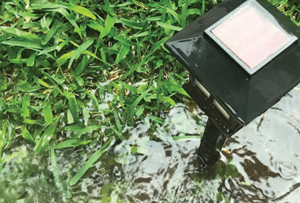 Inspect your yard after a heavy rain. Are there puddles or soggy areas? Has obvious erosion occurred? Has mulch been displaced? Is there standing water on patios, driveways or walkways?
Inspect your yard after a heavy rain. Are there puddles or soggy areas? Has obvious erosion occurred? Has mulch been displaced? Is there standing water on patios, driveways or walkways?- If you have French drain outlets in your yard, check their output with the next heavy rain. Water should be flowing well and easily, moving to a lower grade. If it is not, an issue with the drain can cause serious issues that are often not caught until flooding damage is done.
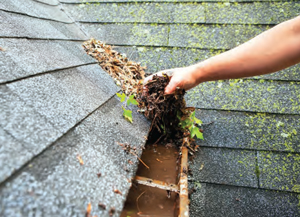 Check your gutters and downspouts. Ensure that they are all interconnected tightly and lead to an appropriate outlet according to the volume of water from the roof. These outlet options can range from a small decorative splash block to underground drain tubing that follows the slope of the yard. Whatever the size, make sure that water is being moved away from your home’s foundation. Not only can water cause flooding damage, improper downspouts and outlets can cause large forces of water to destroy landscaping beds, damage plants, displace mulch, and create unsightly trenches in your yard.
Check your gutters and downspouts. Ensure that they are all interconnected tightly and lead to an appropriate outlet according to the volume of water from the roof. These outlet options can range from a small decorative splash block to underground drain tubing that follows the slope of the yard. Whatever the size, make sure that water is being moved away from your home’s foundation. Not only can water cause flooding damage, improper downspouts and outlets can cause large forces of water to destroy landscaping beds, damage plants, displace mulch, and create unsightly trenches in your yard. 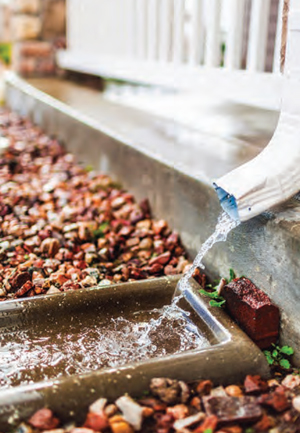 Make sure that leaves and debris are cleared and that no objects are blocking the downspouts. Blockages can create overspill that falls right at the base of your home. This simple check can save you thousands of dollars in damages by preventing flooding in your basement or risking the integrity of your foundation.
Make sure that leaves and debris are cleared and that no objects are blocking the downspouts. Blockages can create overspill that falls right at the base of your home. This simple check can save you thousands of dollars in damages by preventing flooding in your basement or risking the integrity of your foundation.
Solutions for drainage problems in your yard can range from relatively minor DIY fixes to more extensive projects requiring professional assistance. Some solutions include:
GRADING: Grading your land so that water slopes away from your home is one of the most common first steps in remediating larger-scale drainage problems. This solution requires small construction equipment, as well as knowledge about slope pathways in relation to home foundations, neighboring properties, and nearby streets and ditches, which are all impacted by water flow created by grading.
DRAINS: Installing French drains is a standard building practice in which a trench is dug near the base of the home leading down slope. The trench is filled with gravel and corrugated piping to ensure that water is always flowing away from the home’s foundation. However, French drains can sometimes become crushed with land settlement, invaded with roots, or their outlets can become clogged, which can cause flooding near the foundation of the home. If you notice that water is not flowing well at your French drain outlet in your yard, first check the outlet to see if it is an easily remedied clog. If not, you may need to check the drain’s status by inspecting underground. This will require digging a trench to physically inspect the drain tubing and discover the cause of the blockage.
The installation of underground PVC drain piping, underground catch basins, or yard drains may be workable solutions to help move water away from soggy yard areas and disperse the water. Underground piping generally involves digging trench lines in the yard and installing appropriately-sized piping. Just as with grading, trenching and laying lines requires knowledge of slope and state building codes.
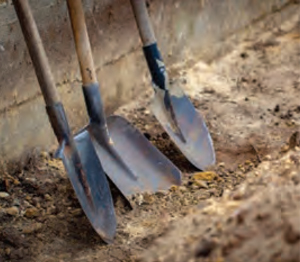 BERMS OR SWALES: If your home is located on a downgrade or is downhill from runoff from a neighboring property, the creation of a berm or swale can help to divert water away from your home. A berm is a rounded mound of compacted soil, typically crescent shaped, whose function is to add visual interest to landscaping while also helping divert rainwater in a yard. Berms are also a beautiful location for adding plantings, boulders and small trees to add character to your property. A swale, also commonly known as a gutter or ditch, is a trench commonly found near driveways and also along sloping contours of yards. Sometimes swales are naturally-formed, and sometimes manmade to control the flow of storm water. While swales are not commonly used to add beauty to your yard, they are sometimes a necessary measure to protect your home or a neighboring property from excessive water run-off.
BERMS OR SWALES: If your home is located on a downgrade or is downhill from runoff from a neighboring property, the creation of a berm or swale can help to divert water away from your home. A berm is a rounded mound of compacted soil, typically crescent shaped, whose function is to add visual interest to landscaping while also helping divert rainwater in a yard. Berms are also a beautiful location for adding plantings, boulders and small trees to add character to your property. A swale, also commonly known as a gutter or ditch, is a trench commonly found near driveways and also along sloping contours of yards. Sometimes swales are naturally-formed, and sometimes manmade to control the flow of storm water. While swales are not commonly used to add beauty to your yard, they are sometimes a necessary measure to protect your home or a neighboring property from excessive water run-off.
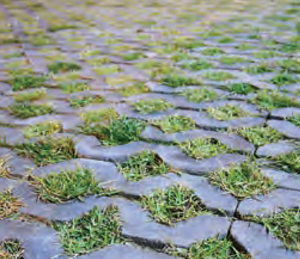 PERMEABLE PAVERS: A beautiful and functional solution for areas like walkways, driveways or patios, is the installation of permeable pavers. Installing permeable pavers is an environmentally responsible decision to avoid overstressing storm drainage waterways and to allow the water runoff to percolate naturally back into the ground. The installation of these pavers requires expert advice on slope, very specific base preparation and leveling, stone cutting, and paver installation. Many mistakenly believe that “permeable” means the water flows through the stone; however, the permeability of them is that the water is allowed to flow through the joints to a crushed stone underlayment that manages water flow.
PERMEABLE PAVERS: A beautiful and functional solution for areas like walkways, driveways or patios, is the installation of permeable pavers. Installing permeable pavers is an environmentally responsible decision to avoid overstressing storm drainage waterways and to allow the water runoff to percolate naturally back into the ground. The installation of these pavers requires expert advice on slope, very specific base preparation and leveling, stone cutting, and paver installation. Many mistakenly believe that “permeable” means the water flows through the stone; however, the permeability of them is that the water is allowed to flow through the joints to a crushed stone underlayment that manages water flow.
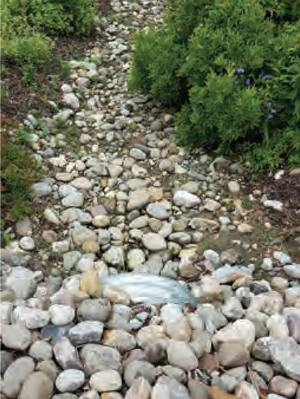 DRY CREEK BEDS: Installing a dry creek bed is a beautiful and practical solution for areas that tend to have a natural water flow. This involves placing larger decorative rocks along the natural erosion line on a lawn to eliminate further erosion. This creek bed offers stability to the land and is often incorporated as part of a greater landscaping design plan that features plantings and borders for an integrated look.
DRY CREEK BEDS: Installing a dry creek bed is a beautiful and practical solution for areas that tend to have a natural water flow. This involves placing larger decorative rocks along the natural erosion line on a lawn to eliminate further erosion. This creek bed offers stability to the land and is often incorporated as part of a greater landscaping design plan that features plantings and borders for an integrated look.
Drainage issues can come with the territory of living among these rolling hills and gorgeous scenic views. Diligent homeowners who identify water and drainage issues early can remedy problems before they become an unexpected expense. Often these solutions also add value by improving and beautifying the property, so that maximum enjoyment can be had with the investment. ✦
BERMS OR SWALES, Blockages, DRAINS, driveways, DRY CREEK BEDS, French drain, GRADING, improve, Patios, PERMEABLE PAVERS, Walkways, water drainage, yard
